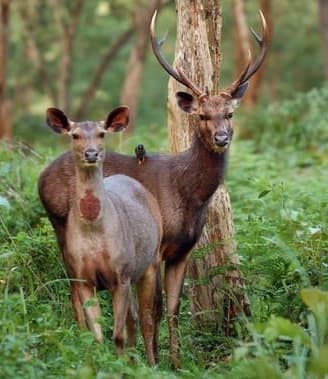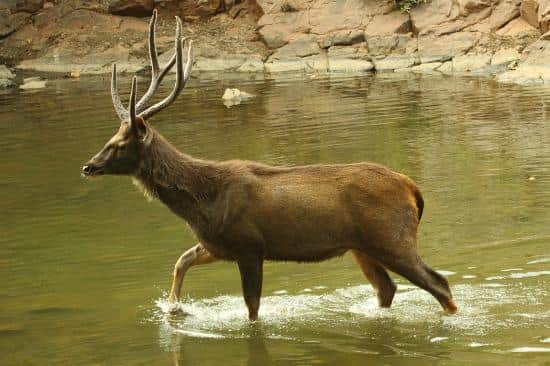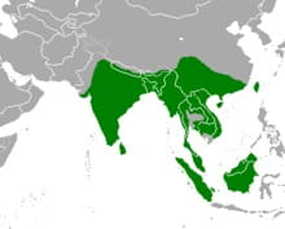Sambar DeerRusa unicolor |

Custom Search
|
|
The Sambar deer (Rusa unicolor) is a deer species natively found in Southeast Asia south of the Himalayas from the Indian subcontinent in the West to southern China (including Hainan Island) in the East.
Their range extends south into Indochina, Myanmar (Burma), Thailand, the Malay Peninsula, Taiwan, and the Indonesian islands of Sumatra and Borneo. There are 7 subspecies of sambar deer currently recognized, and they are considered one of the largest members of deer family. Due to the species wide range across southern Asia their habitats vary enormously.Usually they prefer to live in tropical dry or seasonal forests, subtropical mixed forests or tropical rainforests. But these deer are seldom found far from a water source. The species home range is also probably quite variable but in India males have been recorded to have a ranges of around 1,500 ha (3,700 acres) and females about 300 ha (740 acres). In the wild the Sambar deer may live up to 20 years while in captivity they amy reach 26 years.
Subspecies / Taxonomy / Etymology
Currently, the Sambar deer has 7 subspecies recognised by scientists one of which considered extinct while many others have been proposed but not widely accepted. Bonin sambar deer (R. u. boninensis) - Formerly found in the Bonin Islands is now considered extinct. Bornean sambar deer (R. u. brookei) - Found in Borneo. Sambar deer (R. u. cambojensis) - It inhabits the mainland Southeast Asia. South China sambar deer (R. u. dejeani) - Found in Southern and southwestern regions of China. Malayan sambar deer (R. u. equina) - Found in Sumatra. Hainan sambar deer (R. u. hainana) - Found only in the Hainan Island, part of the smallest and southernmost province of China. Formosan sambar deer (R. u. swinhoii) - Found in Taiwan. Sri Lankan sambar deer (R. u. unicolor) - Found not only in Sri Lankan but also neighbouring India and Bangladesh. Diet / Feeding
They are very opportunistic eaters and will make the most out of any food source they find in their environment. The sambar deer's diet includes many different plants, some of their subspecies feed on 130 and 180 different plant species. They eat water plants, leaves, bamboo shoots, grass, berries, different types of fruits and even old pine tree bark is occasionally torn and eaten. They will also eat root crops like swedes or pasture crops like maize. These deer are capable of eating coarse foods such as bark or flax because their rumination process is efficient than that of other deer species. Their large size also means that the Sambar Deer eats a lot of food every single day. Reproduction The sambar deer mate and reproduce all year-round but the breeding period peaks during the months of November and December. Males establish a territory, and try to attracts nearby females, even so they don't establish a harem like other deer species. Male will stomps the ground to create a bare patch, and are often seen wallowing in the mud. The gestation period lasts around 8 months or maybe slightly longer, and usually only one calf is born although occasionally twins are born. The young deer are weaned at about 7 months of age and will remain with the mother until they reach about 2 years of age. Conservation status and major threats The Sambar deer is listed as a Vulnerable species ion the IUCN Red list, because of the sustained decline in their population across its range and may even become endangered in the near future The main threats to the species include habitat loss due to deforestation, poaching for their beautiful antlers and meat. Like other species different parts of the Sambar body are also used in traditional Asian medicine which further decreases their numbers in the wild.
|
Scientific classification
Kingdom: Animalia Phylum: Chordata Class: Mammalia Order: Artiodactyla Family: Cervidae Subfamily: Cervinae Genus: Rusa Species: R. unicolor |



